
A national flag is a flag that represents and symbolizes a given nation. It is flown by the government of that nation, but usually can also be flown by its citizens. A national flag is typically designed with specific meanings for its colours and symbols, which may also be used separately from the flag as a symbol of the nation. The design of a national flag is sometimes altered after the occurrence of important historical events. The burning or destruction of a national flag is a greatly symbolic act.

The flag of Finland, also called siniristilippu, dates from the beginning of the 20th century. On a white background, it features a blue Nordic cross, which represents Christianity.

The national flag of Romania is a tricolour. The Constitution of Romania states that "The flag of Romania is tricolour; the colours are arranged vertically in the following order from the flagpole: blue, yellow, red". The flag has a width-length ratio of 2:3; the proportions, shades of colour as well as the flag protocol were established by law in 1994, and extended in 2001.

The coat of arms of the Philippines features the eight-rayed sun of the Philippines with each ray representing the eight provinces which were placed under martial law by Governor-General Ramón Blanco Sr. during the Philippine Revolution, and the three five-pointed stars representing the three major island groups of Luzon, the Visayas, and Mindanao.

The national flag of the Philippines is a horizontal bicolor flag with equal bands of royal blue and crimson red, with a white, equilateral triangle at the hoist. In the center of the triangle is a golden-yellow sun with eight primary rays, each representing a province. At each vertex of the triangle is a five-pointed, golden-yellow star, each of which representing one of the country's three main island groups—Luzon, Visayas, and Mindanao. The white triangle at the hoist represents liberty, equality, and fraternity. A unique feature of this flag is its usage to indicate a state of war if it is displayed with the red side on top, which is effectively achieved by flipping the flag upside-down.

The president of the Philippines is the head of state, head of government and chief executive of the Philippines. The president leads the executive branch of the Philippine government and is the commander-in-chief of the Armed Forces of the Philippines.

The seal of the president of the Philippines is a symbol used to represent the history and dignity of the president of the Philippines. Its original form was designed by Captain Galo B. Ocampo, secretary of the Philippine Heraldry Committee, and patterned after the seal of the president of the United States. It was first used by President Manuel Roxas in 1947.

The flag of the United States Navy consists of the seal of the U.S. Department of the Navy in the center, above a yellow scroll inscribed "United States Navy" in dark blue letters, against a dark blue background.
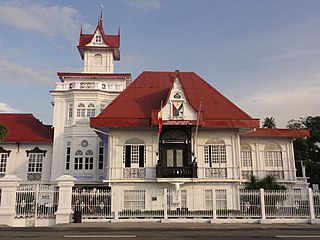
Independence Day is an annual national holiday in the Philippines observed on June 12, commemorating the declaration of Philippine independence from Spain in 1898.
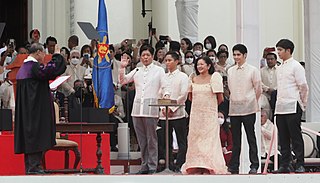
The inauguration of the president of the Republic of the Philippines is a ceremony marking the commencement of the six-year term of a president of the Philippines, who is both head of state and head of government. The inauguration is performed on June 30, as mandated by the 1987 Constitution. Under the older 1935 Constitution, the date was December 30, which is also Rizal Day; the last inauguration held on the older date was Ferdinand Marcos' second one on December 30, 1969. The most recent public presidential inauguration ceremony was that of President Bongbong Marcos, who began his six-year term in office on Thursday, June 30, 2022.

The flag of the president of the United States consists of the presidential coat of arms on a dark blue background. While having the same design as the presidential seal since 1945, the flag has a separate history, and the designs on the flag and seal have at different times influenced each other. The flag is often displayed by the president in official photos, or flown next to the casket of a former president in official funeral processions, and flown on the president's motorcade. The flag is not flown at half-staff since there is always an incumbent president in office. The current flag is defined in Executive Order 10860:
The Color and Flag of the President of the United States shall consist of a dark blue rectangular background of sizes and proportions to conform to military and naval custom, on which shall appear the Coat of Arms of the President in proper colors. The proportions of the elements of the Coat of Arms shall be in direct relation to the hoist, and the fly shall vary according to the customs of the military and naval services.
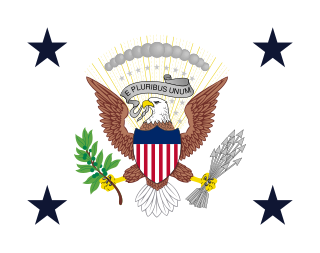
The flag of the vice president of the United States consists of the U.S. vice presidential coat of arms on a white background, with four dark blue stars in the corners. A version of the flag is kept in the vice president's office, is sometimes displayed by the vice president in official photos, and is flown on the vice president's motorcade.

The Seal of the Vice President of the Philippines is a symbol used to represent the history and dignity of the vice president of the Philippines. Its design was prescribed by Executive Order No. 310 of 2004, and is similar in design to the Seal of the President of the Philippines.
The Ang Bagong Lipunan Series is the name used to refer to Philippine banknotes and coins issued by the Central Bank of the Philippines from 1973 to 1985. It was succeeded by the New Design series of banknotes. The lowest denomination of the series is 2-piso and the highest is 100-piso.

The United Nations Honour Flag was a flag symbolizing the Allies of World War II and their goal of world peace. It was designed in October 1942 by Brooks Harding, and it had some degree of use as a flag from 13 June 1943 to c. 1948 to represent the "United Nations" in the sense of the January 1942 Declaration by United Nations. However, it was never an official flag of the United Nations as an organization.

The flag of the vice president of the Philippines consists of the vice presidential coat of arms on a white background. The current flag is defined in Executive Order 310 signed by President Gloria Macapagal Arroyo:
The Flag of the Vice President of the Philippines shall consist of the Coat-of-Arms of the Vice President in proper colors, with a rectangular white background. The fringe shall be of knotted yellow silk. The ratio of the Flag shall be 1:2.

The Seal of Manila is composed of the city's modern coat-of-arms, with colors mirroring those of the Philippine National Flag. It is a modified form of the city's historical arms bestowed in the 16th century.
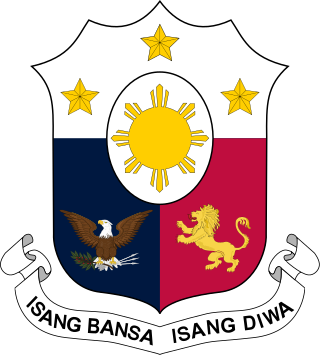
Isang Bansa, Isang Diwa was the national motto of the Philippines from 1978 to 1986, during the presidency of President Ferdinand Marcos. It was adopted on June 9, 1978 by virtue of Presidential Decree No. 1413. The motto has been criticized and has been denounced as "the slogan of a fascist regime".
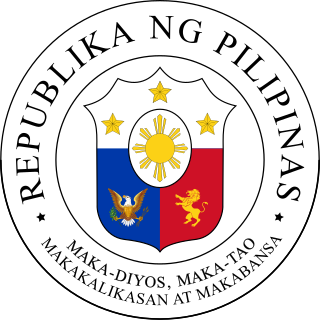
The Great Seal of the Philippines is used to authenticate official documents of the government of the Philippines.

The flag of the President of Colombia It consists, like the flag of Colombia, in a rectangle in yellow, blue and red triband in a 2:1:1 ratio, meaning three horizontal stripes, with yellow at the top occupying half the width of the flag, blue at the bottom. middle occupying a quarter of the width and red below, occupying the last quarter, finished off in the central part with the coat of arms of Colombia.


























